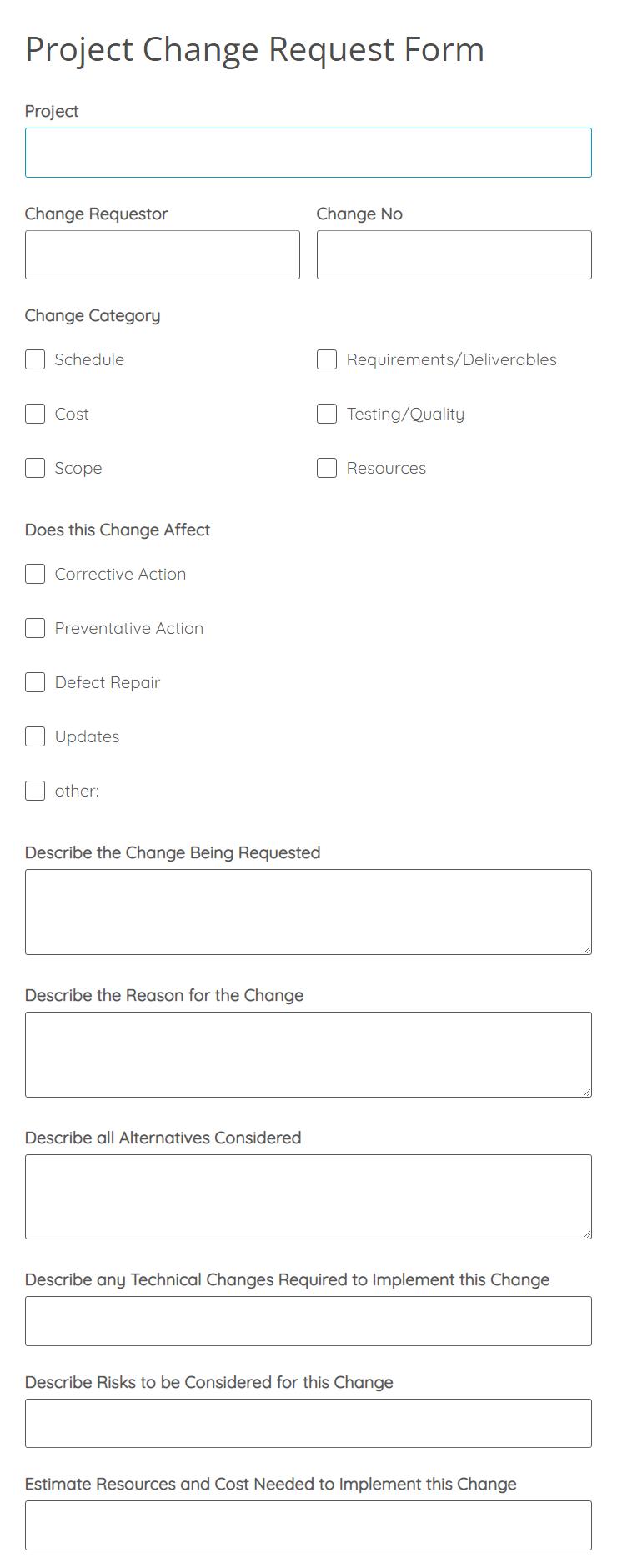Utilizing such a form promotes transparency and control throughout the project lifecycle. It streamlines communication among stakeholders, minimizes misunderstandings, and enables informed decision-making regarding proposed adjustments. This structured process contributes to improved project outcomes by ensuring that changes are carefully considered and their implications fully understood before implementation.

The following sections will explore the key components of these forms, best practices for their implementation, and examples of how they can be adapted to various project scenarios.
Key Components
Effective change management relies on well-structured documentation. Essential elements within a standardized form ensure clarity and completeness when requesting project modifications.
1. Change Identifier: A unique number assigned to each request allows for easy tracking and referencing throughout the project lifecycle.
2. Requestor Information: Details regarding the individual or team initiating the change, including their name, role, and contact information.
3. Date of Request: Records when the change was formally submitted, establishing a clear timeline for processing and implementation.
4. Description of Change: A detailed explanation of the proposed modification, outlining the specific adjustments required.
5. Rationale for Change: Justification for the proposed modification, explaining the reasons necessitating the change.
6. Impact Assessment: Analysis of the potential effects of the change on project scope, budget, timeline, and resources. This includes potential risks and mitigation strategies.
7. Required Approvals: Identification of stakeholders whose authorization is required before the change can be implemented.
8. Implementation Plan: A brief outline of how the change will be executed, including key steps, timelines, and responsible parties.
These core elements provide a comprehensive framework for documenting proposed modifications, ensuring consistent and transparent communication amongst stakeholders and facilitating informed decision-making.
How to Create a Project Change Request Template
Creating a standardized form for project change requests ensures consistent documentation and facilitates effective change management. The following steps outline the process of developing such a template.
1: Define Purpose and Scope: Clearly articulate the purpose of the template and the types of changes it will cover. This ensures the template remains focused and relevant to the specific project needs.
2: Identify Required Information: Determine the essential information needed to assess and process change requests effectively. This typically includes details such as requestor information, change description, rationale, impact assessment, and required approvals.
3: Design the Template Layout: Create a clear and organized layout using a format that allows for easy data entry and review. Consider using tables or structured forms to ensure consistency and readability.
4: Establish Approval Workflows: Define the approval process for change requests, specifying the individuals or roles responsible for authorizing changes. This ensures proper governance and control over project modifications.
5: Develop Instructions and Guidance: Provide clear instructions on how to complete the template and navigate the approval process. This minimizes confusion and ensures requests are submitted correctly.
6: Test and Refine: Pilot test the template with a small group of users to identify potential areas for improvement. Gather feedback and refine the template based on real-world usage.
7: Implement and Communicate: Roll out the template to the project team and stakeholders, providing training and support as needed. Ensure everyone understands how to use the template and its associated processes.
8: Regularly Review and Update: Periodically review the template to ensure it remains aligned with project needs and best practices. Update the template as necessary to reflect changes in project requirements or organizational processes.
A well-designed template provides a structured approach to managing project changes, enabling efficient processing, informed decision-making, and improved project outcomes. Regular review and adaptation maintain its effectiveness throughout the project lifecycle.
Standardized forms for requesting project modifications provide a crucial mechanism for managing change effectively. These structured templates facilitate clear communication, ensure comprehensive documentation, and enable informed decision-making throughout the project lifecycle. From defining the change and its rationale to assessing its impact and outlining the implementation plan, these forms promote transparency and control, minimizing potential disruptions and contributing to successful project delivery. They establish a consistent and auditable process for handling modifications, ensuring alignment with project objectives and stakeholder expectations.
Effective change management is essential for navigating the dynamic nature of projects. Adopting standardized procedures and leveraging well-designed templates empowers organizations to embrace change strategically, maximizing its potential benefits while mitigating associated risks. This proactive approach to change control fosters adaptability, enhances project outcomes, and contributes to overall organizational success.
